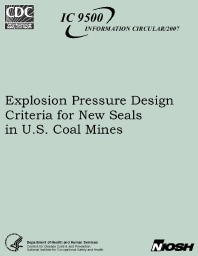Mining Product: Explosion Pressure Design Criteria for New Seals in U.S. Coal Mines
Original creation date: July 2007
Authors: RK Zipf, MJ Sapko, JF Brune
NIOSHTIC2 Number: 20032239
Pittsburgh, PA: U.S. Department of Health and Human Services, Public Health Service, Centers for Disease Control and Prevention, National Institute for Occupational Safety and Health, DHHS (NIOSH) Publication No. 2007-144, Information Circular 9500, 2007 July; :1-76
Seals are used in underground coal mines throughout the United States to isolate abandoned mining areas from the active workings. Prior to the Sago Mine disaster in 2006, mining regulations required seals to withstand a 140-kPa (20-psig) explosion pressure (30 CFR4 75.335(a)(2)). However, Program Information Bulletin No. P06-16 issued by MSHA on July 19, 2006 [McKinney 2006], requires seals to withstand a 345-kPa (50-psig) explosion pressure. The recently enacted MINER Act requires MSHA to increase this design standard by the end of 2007. This report provides a sound scientific and engineering justification to recommend a three-tiered explosion pressure design criterion for new seals in coal mines in response to the MINER Act. The recommendations contained herein apply to new seal design and construction in U.S. coal mines.

NIOSHTIC2 Number: 20032239
Pittsburgh, PA: U.S. Department of Health and Human Services, Public Health Service, Centers for Disease Control and Prevention, National Institute for Occupational Safety and Health, DHHS (NIOSH) Publication No. 2007-144, Information Circular 9500, 2007 July; :1-76
- Compendium of Structural Testing Data for 20-psi Coal Mine Seals
- Composition Change Model for Sealed Atmosphere in Coal Mines
- Demonstration of Safety Plugging of Oil Wells Penetrating Appalachian Coal Mines
- Evaluation of Explosion-Resistant Seals, Stoppings, and Overcast for Ventilation Control in Underground Coal Mining
- Historical Development of Technologies for Controlling Methane in Underground Coal Mines
- Progress Toward Improved Engineering of Seals and Sealed Areas of Coal Mines
- Rock Dusting Considerations in Underground Coal Mines
- Structural Analysis and Design of Seals for Coal Mine Safety
- Technology News 535 - NIOSH Releases New Educational Video: Escape from Farmington No. 9: An Oral History
- Use of Ground Penetrating Radar and Schmidt Hammer Tests to Determine the Structural Integrity of a Mine Seal